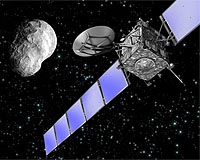|
|
|
Last Visit Home For ESA's Comet Chaser Paris, France (ESA) Oct 21, 2009  ESA's Rosetta comet chaser will swing by Earth on 13 November to pick up orbital energy and begin the final leg of its 10-year journey to the outer Solar System. Several observations of the Earth-Moon system are planned before the spacecraft heads out to study comet 67/P Churyumov-Gerasimenko. This will be the third Earth swingby, the last of Rosetta's four planetary gravity assists. ... read more
ESA's Rosetta comet chaser will swing by Earth on 13 November to pick up orbital energy and begin the final leg of its 10-year journey to the outer Solar System. Several observations of the Earth-Moon system are planned before the spacecraft heads out to study comet 67/P Churyumov-Gerasimenko. This will be the third Earth swingby, the last of Rosetta's four planetary gravity assists. ... read moreSpace Trash And The Great Debate  Bethesda MD (SPX) Oct 21, 2009
Bethesda MD (SPX) Oct 21, 2009Just last week the topic of Space Debris Removal made the "big league" conference circuit at the 60th International Astronautical Congress in Daejeon, Republic of Korea. In fact, in addition to several dedicated sessions on topics addressing almost every aspect of debris production phenomena, improved tracking accuracy, better conjunction prediction methods, advanced mitigation techniques ... more
|
Vietnam says parched Red River at record low
China to be world's third biggest wind power producer: media Cost-cutting NASA eyes three cheap space missions Honduras declares state of emergency amid drought Russia in secret plan to save Earth from asteroid: official Sarkozy scrambles to salvage carbon tax French carbon tax ruled illegal Brazil's Lula signs law cutting CO2 emissions 2009 a 'benign' year of natural disasters: German re-insurer Greenpeace Spain demands Denmark release its director
| |||||||||||||||
| Previous Issues | Oct 20 | Oct 19 | Oct 16 | Oct 15 | Oct 14 |
| . |
Astronomers Again Find Organic Molecules Around Gas Planet Pasadena CA (SPX) Oct 21, 2009
Pasadena CA (SPX) Oct 21, 2009Peering far beyond our solar system, NASA researchers have detected the basic chemistry for life in a second hot gas planet, advancing astronomers toward the goal of being able to characterize planets where life could exist. The planet is not habitable but it has the same chemistry that, if found around a rocky planet in the future, could indicate the presence of life. "It's the second ... more Scientists Use Supercomputers To 'See' Black Holes  Rochester NY (SPX) Oct 21, 2009
Rochester NY (SPX) Oct 21, 2009Scientists at Rochester Institute of Technology have won several grants to further extend their own supercomputer and make use of two of the fastest supercomputers in the world in their quest to "shine light" on black holes. Since light cannot escape from the surface of a black hole, scientists rely upon computer algorithms to study the massive dark objects. Researchers in the Center for ... more Astronomy Question Of The Week: What Does The 'Family Tree' Of Stars Look Like  Bonn, Germany (SPX) Oct 21, 2009
Bonn, Germany (SPX) Oct 21, 2009Not all of the stars in the Universe are the same - differences in brightness and colour can be recognised even with the naked eye. In the 19th century, star spectroscopy developed into an important method of analysis in astronomy: it divides light and other electromagnetic radiation from stars according to its wavelength. For example, visible light is split into the colours of the rainbow ... more |
. |
| . |
NASA'S LCROSS Captures All Phases Of Centaur Impact by Staff Writers
by Staff WritersNASA's Lunar CRater Observation and Sensing Satellite (LCROSS) was a smashing success, returning tantalizing data about the Centaur impact before the spacecraft itself impacted the surface of the moon. Last week, plunging headlong into Cabeus crater, the nine LCROSS instruments successfully captured each phase of the impact sequence: the impact flash ... more NSF Contributes To World's Deepest Underground Lab  Berkeley CA (SPX) Oct 19, 2009
Berkeley CA (SPX) Oct 19, 2009The National Science Foundation (NSF) has authorized more than $29 million for the University of California, Berkeley, to create a preliminary plan for turning a former gold mine in South Dakota into the world's deepest laboratory. The grant, approved Sept. 24 by the National Science Board, is for a preliminary design of the Deep Underground Science and Engineering Laboratory (DUSEL) ... more IBEX Explores Galactic Frontier, Releases First-Ever All-Sky Map  Washington DC (SPX) Oct 16, 2009
Washington DC (SPX) Oct 16, 2009NASA's Interstellar Boundary Explorer, or IBEX, spacecraft has made it possible for scientists to construct the first comprehensive sky map of our solar system and its location in the Milky Way galaxy. The new view will change the way researchers view and study the interaction between our galaxy and sun. The sky map was produced with data that two detectors on the spacecraft collected ... more |
. |
| Previous Issues | Oct 20 | Oct 19 | Oct 16 | Oct 15 | Oct 14 |
| The contents herein, unless otherwise known to be public domain, are Copyright 1995-2009 - SpaceDaily. AFP and UPI Wire Stories are copyright Agence France-Presse and United Press International. ESA Portal Reports are copyright European Space Agency. All NASA sourced material is public domain. Additional copyrights may apply in whole or part to other bona fide parties. Advertising does not imply endorsement, agreement or approval of any opinions, statements or information provided by SpaceDaily on any web page published or hosted by SpaceDaily. Privacy statement |